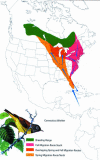Birds, migration and emerging zoonoses: west nile virus, lyme disease, influenza A and enteropathogens
- PMID: 15931279
- PMCID: PMC1069015
- DOI: 10.3121/cmr.1.1.5
Birds, migration and emerging zoonoses: west nile virus, lyme disease, influenza A and enteropathogens
Abstract
Wild birds are important to public health because they carry emerging zoonotic pathogens, either as a reservoir host or by dispersing infected arthropod vectors. In addition, bird migration provides a mechanism for the establishment of new endemic foci of disease at great distances from where an infection was acquired. Birds are central to the epidemiology of West Nile virus (WNV) because they are the main amplifying host of the virus in nature. The initial spread of WNV in the U.S. along the eastern seaboard coincided with a major bird migration corridor. The subsequent rapid movement of the virus inland could have been facilitated by the elliptical migration routes used by many songbirds. A number of bird species can be infected with Borrelia burgdorferi, the etiologic agent of Lyme disease, but most are not competent to transmit the infection to Ixodes ticks. The major role birds play in the geographic expansion of Lyme disease is as dispersers of B. burgdorferi-infected ticks. Aquatic waterfowl are asymptomatic carriers of essentially all hemagglutinin and neuraminidase combinations of influenza A virus. Avian influenza strains do not usually replicate well in humans, but they can undergo genetic reassortment with human strains that co-infect pigs. This can result in new strains with a marked increase in virulence for humans. Wild birds can acquire enteropathogens, such as Salmonella and Campylobacter spp., by feeding on raw sewage and garbage, and can spread these agents to humans directly or by contaminating commercial poultry operations. Conversely, wild birds can acquire drug-resistant enteropathogens from farms and spread these strains along migration routes. Birds contribute to the global spread of emerging infectious diseases in a manner analogous to humans traveling on aircraft. A better understanding of avian migration patterns and infectious diseases of birds would be useful in helping to predict future outbreaks of infections due to emerging zoonotic pathogens.
Figures




Comment on
-
Mosquito surveillance for West Nile virus in southeastern Wisconsin--2002.Clin Med Res. 2003 Jan;1(1):37-42. doi: 10.3121/cmr.1.1.37. Clin Med Res. 2003. PMID: 15931283 Free PMC article.
References
-
- Lederberg J, Shope RE, Oakes SC Jr, editors. Institute of Medicine (U.S.). Committee on Emerging Microbial Threats to Health. Emerging infections: microbial threats to health in the United States. Institute of Medicine, Washington DC: National Academy Press; 1992. - PubMed
-
- List of NIAID emerging and re-emerging diseases. National Institute of Allergy and Infectious Diseases; 2002. [(10/03/2002)]. http://www.niaid.nih.gov/dmid/eid/erd.htm.
-
- Daszak P, Cunningham AA, Hyatt AD. Emerging infectious diseases of wildlife—threats to biodiversity and human health. Science. 2000;287:443–449. - PubMed
-
- Gill FB. Ornithology. 2nd ed. New York: Freeman; 1994.
-
- Rappole JH. The ecology of migrant birds. A Neotropical perspective. Washington DC: Smithsonian Institution Press; 1995.
Publication types
MeSH terms
LinkOut - more resources
Full Text Sources
Medical
Miscellaneous
